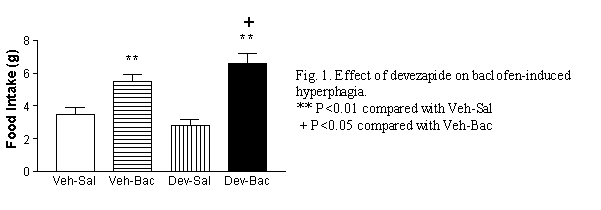| pA2 online © Copyright 2004 The British Pharmacological Society |
106P
University of Bath Summer Meeting July 2004 |
|
Effects of the CCK1 receptor antagonist devazepide on baclofen-induced hyperphagia in non-deprived rats I.S. Ebenezer. Neuropharmacology Research Group, School of Pharmacy and Biomedical Sciences, University of Portsmouth, Portsmouth, PO1 2DT, U.K |
|
Both cholecystokinin (CCK), acting at CCK1 receptors, and GABA, acting at GABAB receptors, have separately been implicated in the physiological control of food intake (Ebenezer, 1990; Patel et al., 2003; Baldwin et al., 1998; Ebenezer, 2003). It was previously demonstrated that the GABAB receptor agonist baclofen attenuates the suppressant effect of peripheral exogenous CCK on food intake, and it was suggested that there may be an interaction between CCK and GABA in the regulation of ingestive behaviour (Ebenezer, 1996). The present study was undertaken to further investigate this suggestion by examining whether the CCK1 receptor antagonist devazepide would modulate the hyperphagic effects of baclofen on food consumption in non-deprived rats.
Male Wistar rats (n=24; b. wt. 380 – 400g) were housed in groups of 4 and had free access to food and water at all times. The rats were divided into 4 equal groups and were injected s.c. with either devazepide (dev) vehicle (veh) followed 15 min later by saline (sal) (Group 1), veh followed by baclofen (bac;
2 mg kg-1) (Group 2), devazepide (dev; 200 µg kg-1) followed by sal (Group 3), or dev 200 µg kg-1) followed by bac (2 mg kg-1) (Group 4). Immediately after the 2nd injection the rats were placed singly in separate experimental cages with free access to food and water for 60 min. Food intake was measured, as described previously (Ebenezer, 1990). The data was analysed by two-way ANOVA and Newman-Keuls post-hoc test.

The results obtained are shown in Fig. 1. Analysis of the results showed that baclofen significantly increased food intake compared with control data. By contrast, devazepide on its own had no significant effects on food consumption. ANOVA revealed a significant interaction between baclofen and devazepide (F(1,20) = 6.148, P<0.02) and post-hoc tests indicated that the combination treatment of devazepide and baclofen produced a significant potentiation in food consumption compared with baclofen (P<0.05) on its own.
The present results strengthen previous findings (Ebenezer, 1996) and suggest that there may be an interaction between the GABA, acting at GABAB receptors and CCK in the control of food intake. Further work is needed to identify the locus for this interaction.
Baldwin BA. et al. (1998) Progress in NeuroBiology, 55, 477 – 507
Ebenezer, I.S. (2003) Eur. J. Pharmacol. 441, 79 – 82
Ebenezer, I.S. (1996) Brain Res. Bull., 41, 269 – 272
Ebenezer, I.S. (1990) NeuroReport, 1, 73 – 76
Patel SM. et al. (2003) Br. J. Pharmacol., 140, 62P